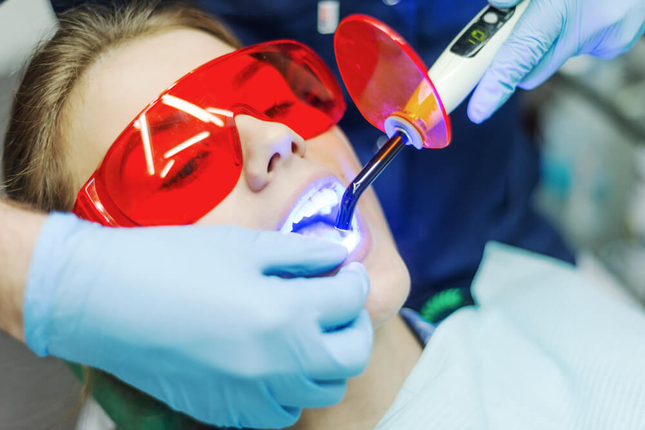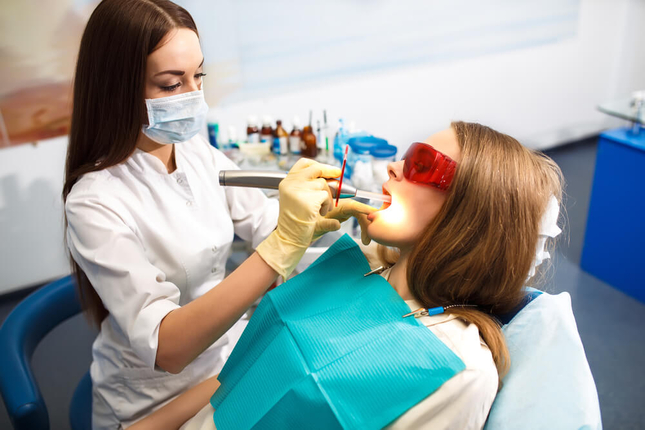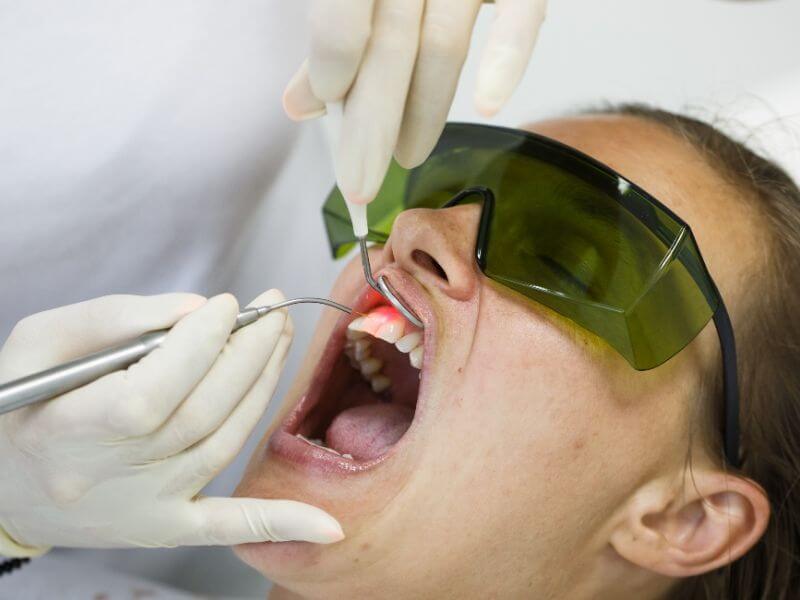LASER DENTISTRY

Laser dentistry is the use of lasers to treat a number of different dental conditions. It potentially offers a more comfortable treatment option for a number of dental procedures involving hard or soft tissue compared to drills and other non-laser tools.
LASER stands for Light Amplification by the Stimulated Emission of Radiation. The instrument creates light energy in a very narrow and focused beam. This laser light produces a reaction when it hits tissue, allowing it to remove or shape the tissue. Lasers can make dental treatments more efficient, cost-effective, and comfortable for the patient.

To be specific, laser dentistry refers to light energy that is a thin beam of extremely focused light, exposed to a particular tissue so that it can be molded or eliminated from the mouth. Throughout the world, laser dentistry is being used for conducting numerous treatments, ranging from simple procedures to rather complex dental procedures.
Here are some of the most common treatments that are done with laser dentistry:
- Teeth whitening
- Treatment of gum diseases
- Treatment of tooth decay
- Treatment of hypersensitivity
Laser dentistry has been previously approved by the United States Food and Drug Administration to be used as a regular dental treatment. One of the reasons why patients prefer laser dentistry is that it has no drilling. This means patients no longer have to hear the loud drilling sounds or feel the vibrations that come with it – making the entire process uncomfortable.
With minor procedures, laser dentistry does not require any anesthesia. The treatment is done while the patients are comfortable and relaxed.
Type of primary lasers
During the laser treatments, two types of lasers are usually used: soft tissue lasers and hard tissue lasers. Both of these lasers have varying wavelengths, which are appropriate for the right cutting or a certain type of tissue. The reason behind different types of lasers is that different kinds of tissues absorb different wavelengths of lights.
- Hard tissue lasers
Hard tissues are typically used for teeth. The wavelength of these lasers can cut through bone and water. They remove the tiny amount of teeth to reshape the tooth or prepare them for other procedures. They are mostly used for the detection of cavities, deal with tooth sensitivity and preparation of teeth for dental fillings.
- Soft tissue lasers
The wavelength of soft tissue lasers can be absorbed by water and hemoglobin easily. Evident by the name, they are used to cut into soft tissues and also seal the blood vessels that are cut through. They are mostly used for modifying the lengthening of crowns, reshaping gums for cosmetic purposes, and treating limited tongue movement.

What to expect during a laser treatment?
The first step is to book an appointment with your dentist. Once the dentist has identified the issue(s) you are suffering from and recommends laser treatment, here are some of the things that usually happen during the procedure:
- Just like a tooth filling procedure, laser treatments are also quite simple.
- There is no drilling in the teeth as the laser does all the work.
- The laser does not produce any pain or discomfort for the patient.
- You might bleed during the procedure, which will be instantly removed by the dentist.
- Your mouth will be opened by the dentist to treat dental issues.
What to expect after a laser treatment?
Once you have gone through laser treatment, here are things that you can generally expect to happen:
In contrast to the drastic bleeding that happens after a traditional dental procedure, laser treatments result in quite less bleeding. The site of treatment will neither be bleeding continuously nor will you have an open wound.
- Compared to other dental treatments, the chances of getting an infection are relatively lesser with laser treatment.
- If the treatment went well, there is minimal to zero probability of you having any pain or swelling.
- If you do have severe swelling or pain in your mouth and it does not go away in a day, do not wait any longer and meet with your dentists right away.

BENEFITS OF LASER DENTISTRY
In addition to reduced or eliminated pain during dental procedures, laser dentistry offers a wide variety of benefits for patients. These can include:
- No need for anesthesia with some procedures
- Reduced risk of bacterial infections – the use of lasers sterilizes the area as it treats
- Decreased need for sutures with some procedures
- Minimal bleeding as the laser promotes blood clotting
- Faster healing times
- Less post-procedure pain and swelling
- Less damage to the surrounding tissue – the focused light produced by lasers allow the dentist to focus on damaged tissue while leaving healthy tissue untouched
- Reduced anxiety and increased comfort – for many people, the sound of a dental drill is enough to keep them from the dentist. Laser treatments are quiet and relatively pain-free, helping patients feel more comfortable and relaxed during treatment.
- Reduced need for medications and antibiotics after treatment

PROCEDURES THAT USE LASER DENTISTRY TREATMENTS
When it comes to laser dentistry, certain lasers focus on the treatment of the teeth while others focus on the treatment of gums and soft tissue. The differences between the lasers depend on their wavelength and the type of tissue they target. For example, the light wavelengths used by soft tissue lasers are easily absorbed by hemoglobin and water, making them ideal for gum and tissue treatment. In contrast, the wavelengths used with hard tissue lasers work with the calcium phosphate salt in your teeth and bones, making them ideal for specific procedures of the teeth. The specific dental work you require will determine the type of laser your dentist uses.
HARD TISSUE PROCEDURES
Hard tissue lasers use wavelengths that are absorbed through water and the calcium phosphate salt inside the tooth or bone. Dentists use these lasers to cut this hard tissue. Hard lasers reduce the need for anesthesia for procedures such as fillings. Common procedures that use hard lasers include:
- Prepare and shape teeth prior to composite bonding
- Repair worn-out or damaged fillings
- Remove minor amounts of tooth structure
- Treating teeth sensitivity – sensitivity to hot and cold is the result of the open tub
SOFT TISSUE PROCEDURES
The wavelengths in soft tissue lasers are easily absorbed by hemoglobin (a molecule found in the blood) and water. This makes them ideal for treating gum issues as they can cut into soft tissue while simultaneously sealing exposed blood vessels. This helps to reduce bleeding and reduce your healing time. In addition, laser treatments effectively kill bacteria in the mouth, reducing your risk of infection after treatment. Common procedures performed with soft lasers include:
- Gum disease – the traditional treatment for mild to severe gum disease can include scaling and root planing to remove plaque and tartar as well as bone grafting or soft tissue grafting. Laser gum surgery eliminates these procedures as the laser can remove inflamed or dead tissue while killing bacteria.
- Correcting uneven or disproportionate gum lines
- Address restricted tongue movement
- Lengthening crowns
- Removing folds in oral soft tissue often caused by dentures
ADDITIONAL LASER DENTISTRY PROCEDURES
In addition to soft and hard laser treatment options, laser dentistry has other applications. Specific lasers can help you avoid dental x-rays and their associated risks by identifying tooth decay before it is visible to the naked eye. Your dentist can then treat the tooth decay with hard and soft tissue treatments.
Laser whitening is another laser dental option commonly used to help brighten and improve your smile. After your dentist places whitening gel on your teeth, lasers help speed up the process and produce much whiter and brighter results.
Lasers have also made a big difference when it comes to crowns, veneers, and bridges. Laser CAD/CAM technology allows your dentist to produce more precise teeth impressions, making the procedures much more comfortable for patients.
